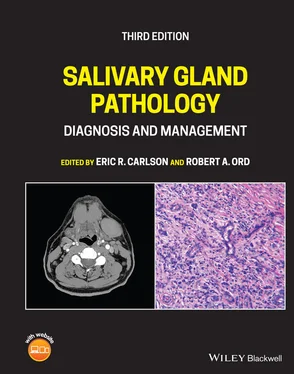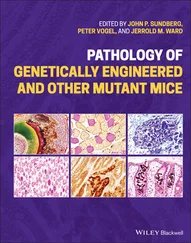What are the vagaries in defining the SMAS layer, can cell type be distinguished on the basis of imaging alone, what influence do genomics and biomarkers have in clinical classification, does contemporary understanding explain the etiology of mucous escape phenomena? Up‐to‐date propositions on such topics occupy these chapters. Clinical challenges, traditional and new, e.g., transection of ducts and nerves, intraductal micromanipulations, salivary diagnostics – they're all here, presented in clear, expansive, prose (28 pages of information on sialolithiasis alone!). The detriments of age and metabolic disorder on gland function, the genesis of non‐salivary tumors inside the glands, and the lodging of metastatic disease within their confines receive emphasis in these pages. So do the presence of aberrant glands and the esoteric transplantation of salivary tissue in the management of xerophthalmia.
The Textbook and Color Atlas of Salivary Gland Pathology is authoritative. Its authors do not write anecdotally, but from the combined experience of decades which has elevated them both to international recognition in the field of head and neck neoplasia. Their clinical material here presented represents volumes in the operating room, and the comprehensive bibliographies in each of the text's chapters testify to the authors' awareness of their topic and their world‐views. Eric Carlson displays the fruits of his earlier endeavors in Pittsburgh, Detroit, and Miami, and speaks now from his position as Professor and Chairman in the Department of Oral and Maxillofacial Surgery at the University of Tennessee Graduate School of Medicine in Knoxville. Robert Ord established his worthy reputation in Britain before resettling himself in Baltimore on the western shores of the Atlantic some 20 years ago, where he now serves as Professor and Chairman of the Department of Oral and Maxillofacial Surgery at the University of Maryland. Theirs is the first time in this domain engineered authoritatively by oral and maxillofacial surgeons, and does honor to their colleagues and forebears in the specialty who have toiled in the vineyards of salivary gland pathology. Neither in design nor execution, however, is their marvelous achievement directed to a parochial audience. Rather, surgeons or clinicians of whatever ilk will offer the authors a nod of appreciation in benefitting from this text.
Probably, one day, an expansion of this work will be written; and, undoubtedly, Carlson and Ord will write it.
R. Bruce MacIntosh, DDS
Detroit
June 2008
Casual students of surgery of pathology might be inclined to ask what can possibly have transpired over the past seven years to warrant a new edition of a text concerning salivary gland dysfunction only first published in 2008. The prevalence of salivary gland neoplasia in comparison to other oral tumors is very small, and to whole body cancer even smaller; significant trauma to the glands ranks low in incidence compared to the rest of maxillofacial injuries; no one dies from inflammatory or immune disease of the glands; don't these facts mitigate against the need for a new textbook on the salivary glands every few years?
Quite the contrary! Because the 2008 Carlson‐Ord volume was one of the very few works – and certainly the most comprehensive – dedicated solely to their topic, it is almost mandatory that it be reviewed and up‐dated on a regular basis to provide clinicians and educators an authoritative repository of new information in this specialized field of interest.
And, indeed, there is new information! The complexity, variety, and heterogeneity in the origins of salivary gland tumors (as discussed in the new Chapter 8) makes these lesions an ideal study group for the development of all malignant neoplasia; they give credence to the notion that all disease, particularly malignant, is ultimately individualized and not to be boxed into currently recognized classifications. Senior readers will well remember the teaching axiom that salivary gland malignancies are impervious to radiation therapy; this new edition's Chapter 12effectively disassembles that contention. Concurrently with the burgeoning understanding of cellular pathology at the subcellular and molecular levels, the concept of systemic chemotherapy, even targeted therapy, for salivary gland cancers has demanded re‐evaluation over the past decade; this is illuminated in the new Chapter 13. Further, the authors have combined their first‐hand knowledge with a compilation of all pertinent literature to offer a unique assembly of pediatric salivary gland pathology in Chapter 15, another addition.
While new knowledge – most excitingly provided in Chapters 8, 12, and 13– and updated bibliographies, sketches, highlighted algorithms, and investigational studies are features of the new text, the focus of these elements and the overall emphasis of the work remains the surgical treatment of patients. Illustrative surgeries from the first edition have been retained, and new cases added to demonstrate principles and additional techniques. Management of the more common salivary tumors, injuries, and infections is well exhibited, but room is provided for illustration of rarer entities (Primary desmoid melanoma of the parotid?! Central (osseous) mucoepidermoid carcinoma of the mandibular ramus?!). Mundane or rare, the range of these maladies, plus the scope and depth of their demonstrated knowledge, attest to the broad experiences of Carlson and Ord in the field of salivary gland abnormality, and deservedly position them in the upper echelons of American salivary gland surgeons.
One could anticipate in 2008 that Carlson‐Ord would recognize the abiding need for pertinence and currency in their text; indeed, they have and have delivered again.
Robert Bruce MacIntosh, DDS
Department of Oral and Maxillofacial Surgery, University of Detroit Mercy School of Dentistry, Detroit, MI, USA
What defines dedication if not the willing contribution of countless hours, huge blocks of energy, and outpouring of intellect and meaningful experience to construct a landmark scientific text? Indeed, these were the elements that Eric Carlson and Robert Ord mobilized in 2008 in introducing to the surgical world their first – now landmark – textbook on salivary gland pathology and treatment. Their dedication to the topic was intense – they had elevated it to the level of subspecialty – and the volume’s success prompted an updated second edition in 2016. Now, with Carlson‐Ord‐III, they have answered the continuing demand and – because of progress within the discipline – the need, for integration of previous writing with new information in the field.
To be a good scientific writer, an author must first be a good teacher, ready to anticipate uncertainties, confusion, or missed emphasis in the minds of his less‐initiated readers, but also ready to anticipate the worthy critique of an experienced colleague. Both Carlson and Ord have easily answered this requirement, not only in their decades‐long responsibilities in the resident education milieu but in countless lecture engagements, conferences, and surgical activities worldwide. Their word on the topic of salivary gland maladies is authority, and it is effectively transmitted both in the operating room and from the podium.
Some say today that a textbook is passé, that what is important in the literature can be much more efficiently harvested through one’s fingertips on a computer. The good textbook is bifocal, however: It must be a lightning rod for all that is new and exciting at the time of printing, but also an entombed repository of everything pertinent that has been recorded up to that date. To honor the functions, the authors have labored diligently to review and update the bibliographies of the texted materials, including pertinent meta‐analyses of earlier literature, and inserting more descriptive visuals of earlier material where appropriate. New features of this Third Edition include greater than 100 new full‐color images, illustrated case presentations to demonstrate important clinical situations, and new chapters on minimally invasive surgery and the complications of surgery in the field. The roster of contributing faculty now numbers 14. With this detailed review and revision, the new edition provides an edited compilation of salivary gland pathology not readily recoverable through journal review, regardless how efficient.
Читать дальше












